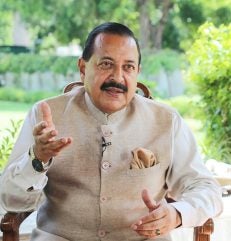
US Department of Energy (DOE) has granted regulatory approval for Holtec International to transfer small modular reactor (SMR) technology to India. This paves the way for increased nuclear cooperation and bolsters India’s standing in the global SMR market. Doe granted the approval under regulation 10CFR810, which is part of the US Atomic Energy Act of 1954.
The authorisation enables Holtec to share its unclassified SMR technology with Holtec Asia, Tata Consulting Engineers Ltd, and Larsen & Toubro Ltd. This will facilitate the localisation of SMR manufacturing, enhance India’s nuclear expertise, and contribute to the growth of its clean energy infrastructure.
However, the approval comes with stringent conditions. The technology can only be used for peaceful nuclear purposes under the safeguards of the International Atomic Energy Agency (IAEA). Holtec is also mandated to submit quarterly reports to DOE detailing the transfer of technology and support provided. The authorisation is valid for 10 years, with a review scheduled after five years to ensure consistent monitoring and compliance with regulatory standards.
The approval overcomes a significant regulatory hurdle that had hindered the commercial implementation of the 2007 India-US civil nuclear agreement. By promoting nuclear energy as a clean and sustainable power source, the agreement aligns with India’s climate goals.
India’s collaboration with Holtec is expected to accelerate the deployment of SMRs, offering a flexible and scalable solution for clean energy production. This advancement is expected to attract further investment in nuclear infrastructure and strengthen India’s role in the global nuclear energy landscape.
Holtec International is led by Indian-American Kris P Singh, while, Holtec Asia has been operating in Pune since 2010. The company also has a factory in Gujarat. Holtec had reportedly earlier informed the Indian government that they also wanted to provide their technology to three government companies – Nuclear Power Corporation of India Limited (NPCIL), National Thermal Power Corporation (NTPC) Ltd, and the Atomic Energy Regulatory Board (AERB). However, they have not yet received approval.
In an opinion piece for the Indian Express, India’s Union Minister of State for Science & Technology and Earth Sciences, Dr Jitendra Singh, said India’s electricity demand is projected to triple by 2047, but nearly 70% of power generation still comes from fossil fuels. “This paradox defines India’s energy challenge – how to promote rapid economic growth while simultaneously reducing carbon emissions and ensuring energy security. Nuclear power has emerged as a crucial pillar in India’s quest for a sustainable and self-reliant energy future.”
He said India faces a number of challenges. “The country’s heavy dependence on imported fossil fuels not only strains the economy but also increases vulnerability to global price fluctuations. Simultaneously, as a signatory to international climate agreements, India has committed to reducing its carbon footprint significantly.” However, nuclear power provides reliable baseload generation regardless of weather conditions and seasonal variations and ecological concerns offering a sustainable alternative.
India’s nuclear journey began shortly after Independence with the establishment of the Atomic Energy Commission in 1948, Dr Singh said. “In 1956, Asia’s first research reactor, Apsara, was commissioned at the Bhabha Atomic Research Centre (BARC) in Trombay. These early steps laid the foundation for what would become one of the world’s most comprehensive nuclear programmes.”
He added: “Today, India’s nuclear landscape has transformed. From a mere 4,780 MWe in 2013-14, nuclear capacity has surged by over 70% to reach 8,180 MWe, spread across 24 operational reactors…. While nuclear power currently contributes approximately 3% of India’s electricity generation, this figure is set to grow substantially with 21 reactors totalling 15,300 MWe at various stages of implementation.”
The focus has shifted from merely expanding capacity to developing indigenous technology. “The successful commissioning of India’s first indigenous 700 MWe Pressurised Heavy Water Reactor (PHWR) at Kakrapar, Gujarat in 2023-24 marks a significant milestone in self-reliance. The country has also made strides in nuclear fuel cycle capabilities, with the Prototype Fast Breeder Reactor (PFBR) achieving critical milestones in 2024, including primary sodium filling and commissioning of sodium pumps. The country has mastered the design and construction of PHWRs. Fast Breeder Reactor technology has moved from the drawing board to reality with the 500 MWe Prototype Fast Breeder Reactor nearing completion. This second stage of India’s nuclear programme is crucial as it multiplies fuel utilisation efficiency and prepares the ground for the thorium-based third stage.”
Dr Singh pointed to the focus on Small Modular Reactors (SMRs) and Bharat Small Reactors (BSRs) as a revolutionary development. “The budget has allocated Rs 20,000 crore [$23m] for SMR research and development, aiming to develop at least five indigenously designed operational SMRs by 2033. BSRs, essentially 220 MWe PHWRs with proven safety and performance records, are being upgraded to reduce land requirements, making them suitable for deployment near industries as captive power plants to aid in decarbonisation efforts.” The government has set a target of 100 GWe nuclear power capacity by 2047, up from 8.18 GWe today.
International collaborations have been reinvigorated, he noted, particularly with Russia, France, and the US. “The government has accorded in-principle approval to set up six 1,208 MWe nuclear power plants in cooperation with the US at Kovvada in Andhra Pradesh.” Another significant development is the partnership between NPCIL and NTPC, forming the ASHVINI joint venture to develop nuclear power facilities. “To facilitate private sector participation, amendments to the Atomic Energy Act and Civil Liability for Nuclear Damage Act are being considered,” Dr Singh noted.
Meanwhile, public perception and safety concerns continue to influence nuclear expansion, although India’s safety record is good. “In the Department of Atomic Energy, we follow the rule of ‘safety first, production next’. The radiation levels at Indian nuclear facilities are consistently well below global benchmarks, with Kudankulam plant emissions decreasing from 0.081 microsieverts a decade ago to just 0.002 microsieverts today,” he said.
He concluded that the journey ahead will require balancing ambitious expansion with stringent safety protocols, public acceptance, and financial viability. “India’s nuclear programme, in tandem with renewable energy, could reshape the country’s energy landscape.”






